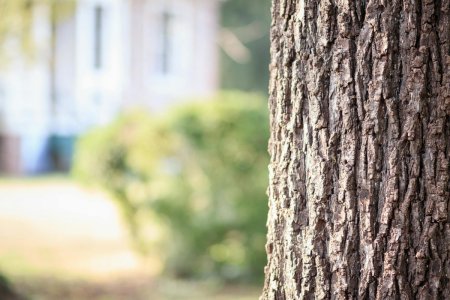Avoid a financial nightmare: This couple's $14,100 fine reveals a shocking rule you didn't know
By
Veronica E.
- Replies 0
Imagine you’re enjoying the peaceful quiet of your backyard, breathing in the fresh air, and savoring the beauty of nature.
But then, out of nowhere, you find out that a simple decision you made about your property could cost you thousands of dollars.
That's exactly what happened to Paula and Matthew Dacey when they decided to clear-cut trees on their property.
Their dream of a well-kept backyard quickly turned into a costly nightmare.
A $14,100 fine, a web of complex regulations, and the surprising consequences of one overlooked rule became their harsh reality.
Keep reading to find out how this happened and how you can avoid similar mistakes.

Paula and Matthew Dacey, property owners on Plover Lane in Nantucket, never imagined that clearing trees would lead to such a hefty fine.
After buying their $1 million property (now worth nearly $4.5 million), the couple decided to remove a half-acre of vegetation to beautify their yard.
Unfortunately, they overlooked a local environmental regulation—and that mistake turned into a $14,100 fine.
The rule they broke? Clear-cutting trees without a permit. What seemed like an innocent landscaping project ended up being a costly oversight.
Clear-cutting is a method that removes most or all trees in an area at once.
It’s often used in timber production or land clearing, but it's also a controversial practice due to the damage it can cause to local ecosystems.
In this case, the Daceys’ decision triggered an investigation by the Nantucket Conservation Commission.
This commission enforces the Wetland Protection Act, a law designed to preserve critical environmental areas, including wetlands, floodplains, and the coast.
The commission didn’t take kindly to the Daceys’ actions, and they hit the couple with a daily $300 fine that would continue until a restoration plan was submitted.
The Wetland Protection Act is a crucial law that helps maintain biodiversity, protects water quality, and prevents flooding.
It ensures that land alterations don’t harm fragile ecosystems.
Before making changes to their property, homeowners need to understand this law and the process for obtaining necessary permits.
It’s a reminder that property ownership isn’t just about what’s on your land—it's about understanding how your actions impact the broader environment.

This situation isn’t unique to the Daceys.
Nantucket has seen similar incidents, like the clear-cutting of 130 Japanese black pines and eastern red cedars.
These actions show a concerning trend where environmental regulations are being ignored for personal gain.
A lawyer involved in the case pointed out that the Daceys’ clear-cutting wasn’t a mistake—it was a deliberate move by a developer trying to boost property value without regard for the environment.
Despite the Daceys’ costly error, the Nantucket Conservation Commission remains determined to restore the area.
While the chance of fully restoring the original vegetation is slim, their goal is to plant native species to help bring the land back to life.
For our readers at The GrayVine, this serves as an important reminder: always be aware of local environmental laws before making changes to your property.
Landscaping may seem like a simple project, but it’s critical to take the time to learn the rules to avoid costly mistakes.
Here’s how to protect yourself and the environment:
While enhancing your property can be a rewarding experience, it's essential to be mindful of the regulations in place to protect our environment.
Paula and Matthew Dacey’s story is a stark reminder that ignorance of local laws can lead to costly consequences.
By staying informed and consulting experts, you can avoid unexpected fines and ensure that your land improvements are not only beautiful but also responsible.
Read next: Iron deficiency without anemia: is it possible?

We’d love to hear from you! Have you faced challenges with property development and environmental conservation? Do you have tips for navigating these tricky regulations? Share your experiences and join the conversation below!
But then, out of nowhere, you find out that a simple decision you made about your property could cost you thousands of dollars.
That's exactly what happened to Paula and Matthew Dacey when they decided to clear-cut trees on their property.
Their dream of a well-kept backyard quickly turned into a costly nightmare.
A $14,100 fine, a web of complex regulations, and the surprising consequences of one overlooked rule became their harsh reality.
Keep reading to find out how this happened and how you can avoid similar mistakes.

Protecting your wallet starts with understanding local property laws. Image Source: Pexels / Jonathan Borba.
The price of ignorance: a costly lesson in conservation
Paula and Matthew Dacey, property owners on Plover Lane in Nantucket, never imagined that clearing trees would lead to such a hefty fine.
After buying their $1 million property (now worth nearly $4.5 million), the couple decided to remove a half-acre of vegetation to beautify their yard.
Unfortunately, they overlooked a local environmental regulation—and that mistake turned into a $14,100 fine.
The rule they broke? Clear-cutting trees without a permit. What seemed like an innocent landscaping project ended up being a costly oversight.
Clear-cutting and the environment
Clear-cutting is a method that removes most or all trees in an area at once.
It’s often used in timber production or land clearing, but it's also a controversial practice due to the damage it can cause to local ecosystems.
In this case, the Daceys’ decision triggered an investigation by the Nantucket Conservation Commission.
This commission enforces the Wetland Protection Act, a law designed to preserve critical environmental areas, including wetlands, floodplains, and the coast.
The commission didn’t take kindly to the Daceys’ actions, and they hit the couple with a daily $300 fine that would continue until a restoration plan was submitted.
Also read: Are you one of the 95% of homeowners about to get hit with a $300 fine? Here’s how to avoid it before April 1
What is the Wetland Protection Act?
The Wetland Protection Act is a crucial law that helps maintain biodiversity, protects water quality, and prevents flooding.
It ensures that land alterations don’t harm fragile ecosystems.
Before making changes to their property, homeowners need to understand this law and the process for obtaining necessary permits.
It’s a reminder that property ownership isn’t just about what’s on your land—it's about understanding how your actions impact the broader environment.

Be aware of the impact your landscaping decisions can have on both your property and the environment. Image Source: Pexels / Michael Morse.
Also read: Avoid a $200 fine with this simple tip: Why it’s good to disconnect
The cost of non-compliance
This situation isn’t unique to the Daceys.
Nantucket has seen similar incidents, like the clear-cutting of 130 Japanese black pines and eastern red cedars.
These actions show a concerning trend where environmental regulations are being ignored for personal gain.
A lawyer involved in the case pointed out that the Daceys’ clear-cutting wasn’t a mistake—it was a deliberate move by a developer trying to boost property value without regard for the environment.
Despite the Daceys’ costly error, the Nantucket Conservation Commission remains determined to restore the area.
While the chance of fully restoring the original vegetation is slim, their goal is to plant native species to help bring the land back to life.
Also read: Ford in hot water: Regulators launch new probes after massive fine
Protect your wallet and the environment
For our readers at The GrayVine, this serves as an important reminder: always be aware of local environmental laws before making changes to your property.
Landscaping may seem like a simple project, but it’s critical to take the time to learn the rules to avoid costly mistakes.
Here’s how to protect yourself and the environment:
- Research local environmental regulations: Understand what permits are required before you make any changes to your property.
- Consult experts: Speak with environmental consultants or land-use attorneys to ensure you’re following the law.
- Think long-term: Consider how your actions will affect the local ecosystem and community.
- Explore eco-friendly alternatives: There are many landscaping options that enhance your property while also preserving the environment.
While enhancing your property can be a rewarding experience, it's essential to be mindful of the regulations in place to protect our environment.
Paula and Matthew Dacey’s story is a stark reminder that ignorance of local laws can lead to costly consequences.
By staying informed and consulting experts, you can avoid unexpected fines and ensure that your land improvements are not only beautiful but also responsible.
Read next: Iron deficiency without anemia: is it possible?
Key Takeaways
- Homeowners in Nantucket were fined $14,100 for clear-cutting trees on their own property without a permit, which is a violation of local regulations.
- The conservation commission is enforcing the penalties in order to uphold the Wetland Protection Act and set an example against such environmental violations.
- The property owners are required to submit a restoration plan for the cleared land by March 20, 2025, and are currently facing a $300 daily fee until a restoration plan is agreed upon.
- The commission believes the clear-cutting was intentional to improve property value, despite the environmental damage, highlighting that the owner is a sophisticated developer with knowledge of property and land use.
We’d love to hear from you! Have you faced challenges with property development and environmental conservation? Do you have tips for navigating these tricky regulations? Share your experiences and join the conversation below!






